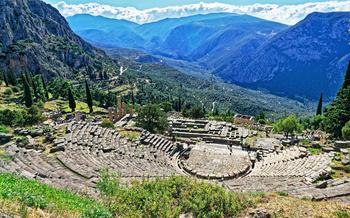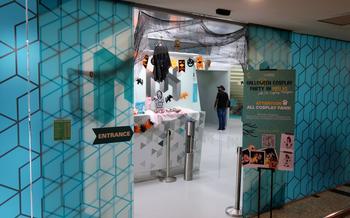
The Archaeological Museum of Mytilene
- History of the Archaeological Museum of Mytilene
- Location of the Museum
- Opening Hours and Admission Fees
- What to Expect at the Museum
- The Museum's Collection
- Archaeology of Mytilene
- Ancient Greek Pottery
- Ancient Greek Sculpture
- Ancient Greek Jewelry
- Ancient Greek Coins
- Ancient Greek Inscriptions
- The Museum's Educational Programs
- The Museum's Temporary Exhibitions
- Accessibility for Visitors with Disabilities
- Insider Tip
History of the Archaeological Museum of Mytilene
The Archaeological Museum of Mytilene is a treasure trove of ancient artifacts that provide a glimpse into the rich history and culture of the island of Lesbos. The museum's collection spans from the Neolithic period to the Byzantine era, offering visitors a comprehensive overview of the island's archaeological heritage.
The museum's ancient history is closely intertwined with the rise and fall of the ancient city of Mytilene, the capital of Lesbos. Founded in the 11th century BC, Mytilene was a powerful and prosperous city-state that played a significant role in the political and cultural landscape of the Aegean Sea. The city's wealth and influence attracted visitors from across the ancient world, including famous philosophers, poets, and artists.
In the 6th century AD, Mytilene was conquered by the Byzantine Empire and the city's fortunes declined. However, the city's rich cultural heritage continued to be celebrated and preserved by its inhabitants. In the 19th century, a group of local scholars and historians founded the Archaeological Society of Lesbos, which played a crucial role in the establishment of the Archaeological Museum of Mytilene.
The museum's modern history begins in 1907 when it was officially inaugurated. The museum's first home was a small building in the city center, but as the collection grew, a new and larger building was constructed in 196The current museum building is located in the picturesque district of Varia, on the outskirts of Mytilene.
The Archaeological Museum of Mytilene is an important cultural institution that plays a vital role in preserving and promoting the island's rich archaeological heritage. The museum's collection is a testament to the ingenuity and creativity of the ancient inhabitants of Lesbos, and it continues to inspire and educate visitors from all over the world.
Location of the Museum
The Archaeological Museum of Mytilene is situated in the heart of the city of Mytilene, on the island of Lesbos, Greece. Its exact address is 26, Ermou Street. It is easily accessible by public transportation, with several bus lines stopping within walking distance of the museum. If you are traveling by car, there are several parking lots nearby where you can leave your vehicle.
Opening Hours and Admission Fees
Visiting hours for the Archaeological Museum of Mytilene vary depending on the time of year. From April 1st to October 31st, the museum is open from 8:30 am to 3:00 pm daily. During the winter months, from November 1st to March 31st, the museum's hours are slightly shorter, from 8:30 am to 2:30 pm. The museum is closed on Mondays and public holidays.
The admission fee for the Archaeological Museum of Mytilene is modest, making it an affordable attraction for visitors of all budgets. A standard ticket costs just €2, while senior citizens and students with valid identification can enjoy a discounted rate of €Children under the age of 12 are admitted free of charge.
The museum also offers a combined ticket, which includes admission to the Archaeological Museum of Mytilene, the Mytilene Byzantine Museum, and the Theophilos Museum. This ticket is an excellent value, as it allows visitors to explore three of the city's most important cultural institutions for a single price. The combined ticket costs €4 for adults, €2 for senior citizens and students, and is free for children under
What to Expect at the Museum
When visiting the Archaeological Museum of Mytilene, be ready to embark on a captivating journey through the rich history and culture of Lesbos and the wider Aegean region. Immerse yourself in the beauty and significance of ancient Greek artifacts, spanning from the prehistoric era to the Hellenistic period.
The museum's collection boasts a diverse range of exhibits, including exquisite pottery, intricate sculptures, gleaming jewelry, and historically valuable coins. Each artifact narrates a unique story, providing insights into the daily lives, beliefs, and artistic achievements of ancient civilizations.
Key Highlights of the Museum:
-
Pottery Hall: Marvel at the museum's impressive collection of pottery, showcasing the evolution of ceramic art from the Neolithic period to the Roman era.
-
Sculpture Gallery: Admire the skillfully crafted sculptures that depict gods, heroes, and mythical creatures, offering a glimpse into the religious and mythological beliefs of ancient Greece.
-
Jewelry Room: Be mesmerized by the delicate and intricate jewelry, crafted from gold, silver, and precious stones, showcasing the artistry and craftsmanship of ancient Greek jewelers.
-
Numismatic Collection: Explore the museum's extensive collection of ancient Greek coins, each bearing unique designs and inscriptions that provide valuable insights into economic and political systems of the past.
Plan to spend at least two hours to fully appreciate the museum's treasures. Guided tours are available upon request, offering a deeper understanding and contextualization of the exhibits. These tours are conducted by knowledgeable and passionate guides who bring the ancient world to life, making your visit even more enriching.
The Museum's Collection
The Archaeological Museum of Mytilene houses a diverse collection of artifacts that provide a glimpse into the rich history and culture of the island of Lesbos. Among the highlights of the collection are:
-
A large collection of ancient Greek pottery, including vases, amphorae, and plates, dating from the Neolithic period to the Roman era. These artifacts showcase the artistry and craftsmanship of ancient Greek potters and offer insights into the everyday lives of people in ancient Greece.
-
A collection of ancient Greek sculpture, including statues, busts, and reliefs, dating from the Archaic period to the Hellenistic period. These sculptures depict a variety of subjects, including gods, goddesses, heroes, and everyday people, and provide a glimpse into the religious beliefs and artistic traditions of ancient Greece.
-
A collection of ancient Greek jewelry, including necklaces, earrings, bracelets, and rings, dating from the Bronze Age to the Roman era. These artifacts were often made of gold, silver, or bronze and were often adorned with precious stones or intricate designs. They provide insights into the personal adornment and social status of people in ancient Greece.
-
A collection of ancient Greek coins, dating from the 6th century BC to the 4th century AD. These coins were used for trade and commerce and often feature images of gods, goddesses, or rulers, as well as inscriptions that provide valuable information about the history and politics of ancient Greece.
-
A collection of ancient Greek inscriptions, dating from the Archaic period to the Roman era. These inscriptions are written in a variety of scripts, including Greek, Latin, and Phoenician, and provide insights into the laws, customs, and religious beliefs of people in ancient Greece.
Archaeology of Mytilene
The island of Lesbos, where Mytilene is located, has a rich and fascinating archaeological history. Inhabited since the Neolithic period, the island was home to several ancient Greek city-states, including Mytilene itself. The city was a major cultural and economic center in the ancient world, and its archaeological remains are some of the most impressive in the Aegean.
Some of the most important archaeological sites in Mytilene include the ancient theater, the Roman aqueduct, and the Mytilene Castle. The ancient theater, built in the 3rd century BC, is one of the best-preserved theaters in Greece and has a capacity of over 10,000 people. The Roman aqueduct, built in the 2nd century AD, brought water to the city from a distance of over 10 kilometers. The Mytilene Castle, built in the 14th century by the Genoese, is a massive fortress that dominates the city skyline.
The Archaeological Museum of Mytilene plays a vital role in preserving and showcasing the island's rich archaeological heritage. The museum's collection includes artifacts from all periods of Mytilene's history, from the Neolithic period to the Byzantine period. These artifacts provide valuable insights into the lives and culture of the ancient Greeks and Romans who lived on Lesbos.
Ancient Greek Pottery
Pottery was an essential part of ancient Greek culture, serving various purposes from storing food and liquids to being used in religious ceremonies and as decorative items. The Archaeological Museum of Mytilene houses a significant collection of ancient Greek pottery, showcasing the diverse styles and techniques of this ancient craft.
Visitors can admire a wide range of pottery, including amphorae, large two-handled jars used for transporting and storing wine, oil, and other liquids; kraters, large mixing bowls used for diluting wine with water; hydriae, water jars with three handles; lekythoi, oil flasks used for anointing the body or as grave offerings; and kylikes, shallow drinking cups with two handles.
The museum's collection also features examples of black-figure pottery, a technique in which figures are painted on a black background, and red-figure pottery, a later technique in which the figures are left the natural color of the clay and the background is painted black. These intricate and beautifully decorated vessels provide a glimpse into the artistic achievements and everyday life of ancient Greece.
Ancient Greek Sculpture
Among the many treasures housed within the Archaeological Museum of Mytilene, the collection of ancient Greek sculptures stands out as a testament to the artistry and craftsmanship of the ancient Greeks. These awe-inspiring works of art, carved from marble, bronze, and other materials, depict a wide range of subjects, from gods and goddesses to mythical heroes and everyday people.
The museum's collection includes a variety of different types of sculptures, including statues, busts, reliefs, and statuettes. Some of the most notable pieces include a colossal marble head of Zeus, the king of the gods, and a bronze statue of a young athlete, known as the "Mytilene Kouros." These sculptures are not only aesthetically pleasing but also provide valuable insights into the religious beliefs, cultural values, and artistic techniques of ancient Greece.
Visitors to the museum can marvel at the intricate details and lifelike expressions captured in these ancient works of art. The sculptures offer a glimpse into the lives and minds of the ancient Greeks, showcasing their deep appreciation for beauty, harmony, and the human form.
Ancient Greek Jewelry
The Archaeological Museum of Mytilene boasts an impressive collection of ancient Greek jewelry, offering a glimpse into the exquisite craftsmanship and symbolic significance of adornments in ancient Greece. These precious objects, crafted from gold, silver, and bronze, showcase a remarkable range of designs and techniques.
From delicate necklaces and intricate earrings to elaborate bracelets and ornate rings, the museum's jewelry collection tells a story of personal adornment, cultural identity, and artistic expression. Each piece is a testament to the skill and artistry of ancient Greek goldsmiths, who employed a variety of techniques to create intricate designs and textures.
The symbolism of ancient Greek jewelry is equally fascinating. Many pieces feature motifs and symbols that held deep meaning for their wearers. For example, the snake was a common motif, representing rebirth and transformation, while the owl was associated with wisdom and knowledge. Jewelry was also used to denote social status and wealth, with elaborate pieces often reserved for the elite.
Highlights of the jewelry collection include a stunning gold necklace adorned with intricate filigree work and colorful gemstones, as well as a pair of delicate gold earrings featuring intricate granulation work. These exquisite pieces offer a glimpse into the refined taste and craftsmanship of ancient Greek jewelers.
Ancient Greek Coins
The Archaeological Museum of Mytilene houses a significant collection of ancient Greek coins, offering insights into the economic and political history of the region. These coins, minted in various cities and periods, provide valuable information about trade, commerce, and the monetary system of ancient Greece.
Numismatic enthusiasts and history buffs will be fascinated by the diverse range of coins on display. The collection includes silver and bronze coins, as well as rare gold staters, showcasing the artistry and skill of ancient Greek craftsmen. From the archaic to the Hellenistic era, the coins bear intricate designs and inscriptions, often depicting mythological figures, rulers, and symbols of power.
Studying these coins allows us to trace the evolution of coinage in Greece and understand its role in everyday life. The varying denominations and weights provide insights into the economic transactions and trade networks of the ancient world. The iconography and legends on the coins reveal religious beliefs, political propaganda, and historical events.
Through this collection, the Archaeological Museum of Mytilene offers a glimpse into the financial and political landscape of ancient Greece, making it a valuable resource for researchers and a fascinating attraction for visitors interested in numismatics and ancient history.
Ancient Greek Inscriptions
Ancient Greek inscriptions are another important part of the museum's collection. These inscriptions are written in a variety of ancient Greek scripts, including the Linear B script, the Archaic Greek script, and the Classical Greek script. They date from the Bronze Age to the Roman period.
The inscriptions record a wide range of information, including religious texts, laws, decrees, and dedications. They provide valuable insights into the history, culture, and religion of ancient Greece.
Some of the most notable inscriptions in the museum's collection include the Stele of Mytilene, which records a law code from the 6th century BC, and the Inscribed Base of a Statue of Zeus, which dates from the 4th century BC.
The museum's collection of ancient Greek inscriptions is one of the most important in the world. It is a valuable resource for scholars and researchers, and it provides visitors with a unique glimpse into the world of ancient Greece.
The Museum's Educational Programs
The Archaeological Museum of Mytilene offers a variety of educational programs to help visitors learn more about the ancient history of Lesbos and the region. These programs are designed for people of all ages and interests, and they include interactive activities, lectures, and workshops.
One of the most popular programs is the "Kids' Corner," which is held every Saturday morning. This program is designed for children ages 5-12, and it includes hands-on activities like pottery-making, jewelry-making, and interactive games. Children can learn about ancient Greek culture and history while they have fun creating their own works of art.
The museum also offers a variety of lectures and workshops for adults. These programs are typically held in the evening, and they cover a wide range of topics, such as ancient Greek mythology, archaeology, and history. The museum also hosts special events and workshops throughout the year, such as lectures by visiting experts.
To participate in the museum's educational programs, please visit the museum's website or call the museum directly.
The Museum's Temporary Exhibitions
The Archaeological Museum of Mytilene also hosts a variety of temporary exhibitions throughout the year. These exhibitions often focus on specific aspects of Mytilene's history or culture, or on the work of particular artists or archaeologists. Past exhibitions have included "The Treasures of Mytilene," which showcased some of the most important artifacts from the museum's collection, and "The Art of Ancient Greece," which featured sculptures, pottery, and jewelry from the Classical period.
Temporary exhibitions are usually held in the museum's temporary exhibition gallery, which is located on the ground floor. The gallery is a large, open space that can accommodate a variety of exhibits. Exhibitions typically last for several months, and admission is usually included in the price of a museum ticket.
To find out about upcoming temporary exhibitions, you can check the museum's website or follow the museum on social media. You can also sign up for the museum's email list to receive notifications about upcoming events and exhibitions.
Accessibility for Visitors with Disabilities
The Archaeological Museum of Mytilene is committed to ensuring that all visitors, regardless of their abilities, can enjoy the museum's exhibits and programs.
- Wheelchair Accessibility: The museum is wheelchair accessible, with ramps and elevators providing access to all floors.
- Accessible Restrooms: Several accessible restrooms are located throughout the museum.
- Assistive Listening Devices: Assistive listening devices are available for visitors who are deaf or hard of hearing.
- Museum Staff: The museum staff is trained to assist visitors with disabilities. They can provide information about accessible features and arrange for assistance if needed.
To plan your visit, please contact the museum in advance. They can provide you with specific information about accessibility and arrange for any necessary accommodations.
Insider Tip
-
Little-known fact: The Archaeological Museum of Mytilene houses a rare collection of ancient Greek musical instruments, including lyres, harps, and flutes. These instruments are not typically displayed, but visitors can request to see them upon request.
-
Recommendation for visitors: Take some time to explore the museum's courtyard, where you can see ancient architectural fragments and sculptures that didn't fit inside the museum.
-
Personal anecdote: During my visit to the museum, I was particularly struck by a small, unassuming statue of a young woman. The statue was only about a foot tall, but it was exquisitely carved and captured the woman's beauty and grace perfectly. I stood there for a long time, admiring the statue and wondering about the woman who had inspired it.



